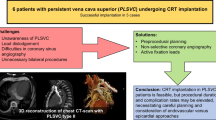Summary
We report an implantation of a cardiac resynchronisation system in a patient with persistent left superior vena cava. This anomaly occurs in 0.3 to 0.5% of healthy individuals and remains usually asymptomatic. Variations of the superior vena cava should be considered in venous catheterization and other procedures such as implantation of pacemaker and ICD systems as well as port catheter insertion. In resynchronisation systems, persistent left superior vena cava can be an obstacle for cannulation of the coronary sinus and placement of a transvenous left ventricular lead.
Zusammenfassung
Wir berichten über die Implantation eines Resynchronisationssystems bei einem Patient mit persistierender oberer Hohlvene. Diese Variante tritt mit einer Häufigkeit von 0,3 to 0,5% auf und ist in der Regel asymptomatisch. Varianten der oberen Hohlvene können die Anlage zentralvenöser Zugänge sowie die Implantation von Herzschrittmachern, ICD- und Portsystemen behindern und haben Konsequenzen für die Elektrodenplatzierung der linksventrikulären Elektrode von Resynchronisationssystemen.
Similar content being viewed by others
References
Josloff RK, Kukora JS (1995) Central venous catheterization via persistent left superior vena cava. Am Surg 61:781–783
Leibowitz AB, Halpern NA, Lee MH, Iberti TJ (1992) Left-sided superior vena cava: a not-so-unusual vascular anomaly discovered during central venous and pulmonary artery catheterization. Crit Care Med 20:1119–1122
Maeso-Madronero JL, Bergbauer M (1997) Temporary and permanent pacemaker provision in persistent left superior vena cava and atresia of the right superior vena cava. Dtsch Med Wochenschr 122:1343–1346
Winter FS (1954) Persistent left superior vena cava; survey of world literature and report of thirty additional cases. Angiology 5:90–132
Schummer W, Schummer C, Frober R (2003) Persistent left superior vena cava and central venous catheter position: clinical impact illustrated by four cases. Surg Radiol Anat 25:315–321
Meijboom WB, Vanderheyden M (2002) Biventricular pacing and persistent left superior vena cava. Case report and review of the literature. Acta Cardiol 57:287–290
Gasparini M, Mantica M, Galimperti P, Coltorti F, Simonini S, Ceriotti C, Gronda E (2003) Biventricular pacing via a persistent left superior vena cava: report of four cases. Pacing Clin Electrophysiol 26:192–196
Lane RE, Chow AW, Mayet J, Davies DW (2003) Biventricular pacing exclusively via a persistent left-sided superior vena cava: case report. Pacing Clin Electrophysiol 26:640–642
Gorr E, Grove R, Weitkamp P, Kranig W, Thale J (2004) Implantation of a biventricular pacing system via a persistent left-sided superior vena cava. Z Kardiol 93:813–817
Author information
Authors and Affiliations
Corresponding author
Rights and permissions
About this article
Cite this article
Reinhardt, D., Surber, R., Kuehnert, H. et al. Implantation eines Resynchronisationssystems bei persistierender oberer Hohlvene. Herzschr. Elektrophys. 17, 35–39 (2006). https://doi.org/10.1007/s00399-006-0505-1
Received:
Accepted:
Issue Date:
DOI: https://doi.org/10.1007/s00399-006-0505-1




